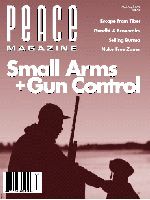
Peace Magazine Mar-Apr 1998, page 30. Some rights reserved.
Search for other articles by Joanna Santa Barbara here
Johan Galtung, Sage, London, 1996. $39.95, 280 pgs
THIS IS A remarkable book: you should read it. Its scope has left me awed and has left my mind improved by concepts and systems of thinking. Any reader will find here new or improved thinking tools to apply to peace education, peace research, and peace work. This book is not easy reading. Galtung has a passion for systems, lists, and tables - which creates hard work for the reader, but I cannot imagine how else to order the huge span of this work.
He begins with defining peace as the absence or reduction of violence: direct (which includes harm to basic needs beyond bodily integrity), structural (the existence of structures that deprive people of basic needs) and cultural (the deep shared assumptions that permit or promote direct and structural violence). He adds to this definition the requirement that conflict be handled creatively and nonviolently. This definition creates the plan of the book. Galtung begins with peace theory,
including two chapters dealing with the basis of peace studies. He then deals with conflict theory and conflict transformation (conflict is never resolved, but transformed). To address structural violence there is a section on development theory in which Galtung gives readers a mini-course on "Six Economic Schools" and treats us to a series of iconoclastic theses on development.
Finally, and especially fascinating: six cosmologies of major, enduring civilizations. He discusses their implications (including Reaganism as an ultra-extreme version of current Occidental cosmology) and explores remedies. I was surprised by Galtung's views on these matters:
The book makes it clear how deep an issue peace is in modern society. "Anybody who in one way or another is opposed to the Occidental war establishment and the military approach to peace and security," writes Galtung, "should realize that this is a fight at the level of deep ideology and deep culture, the level of cosmology." That is a valuable reminder for us all.
Reviewed by Joanna Santa Barbara, a Hamilton, Ontario psychiatrist.

Peace Magazine Mar-Apr 1998, page 30. Some rights reserved.
Search for other articles by Joanna Santa Barbara here